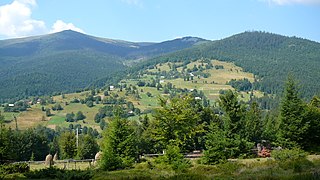
The Battle of Abritus, also known as the Battle of Forum Terebronii, occurred near Abritus in the Roman province of Moesia Inferior in the summer of 251 between the Roman Empire and a federation of Gothic and Scythian tribesmen under the Goth king Cniva. The Roman army of three legions was soundly defeated, and Roman emperors Decius and his son Herennius Etruscus were both killed in battle. They became the first Roman emperors to be killed by a foreign enemy. It was one of the worst defeats suffered by the Roman Empire against Germanics, rated by the Roman historian Ammianus Marcellinus as on par with the Battle of the Teutoburg Forest in AD 9, the Marcomannic invasion of Roman Italy in 170, and the Battle of Adrianople in 378.

Jordanes, also written Jordanis or, uncommonly, Jornandes, was a 6th-century Eastern Roman bureaucrat of Gothic extraction who turned his hand to history later in life.
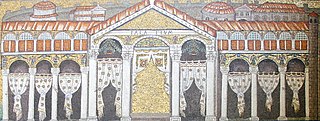
The Ostrogoths were the eastern branch of the older Goths. The Ostrogoths traced their origins to the Greutungi – a branch of the Goths who had migrated southward from the Baltic Sea and established a kingdom north of the Black Sea, during the 3rd and 4th centuries. They built an empire stretching from the Black Sea to the Baltic. The Ostrogoths were probably literate in the 3rd century, and their trade with the Romans was highly developed. Their Danubian kingdom reached its zenith under King Ermanaric, who is said to have committed suicide at an old age when the Huns attacked his people and subjugated them in about 370.

The Visigoths were the western branches of the nomadic tribes of Germanic peoples referred to collectively as the Goths. These tribes flourished and spread throughout the late Roman Empire in Late Antiquity, or what is known as the Migration Period. The Visigoths emerged from earlier Gothic groups who had invaded the Roman Empire beginning in 376 and had defeated the Romans at the Battle of Adrianople in 378. Relations between the Romans and the Visigoths were variable, alternately warring with one another and making treaties when convenient. The Visigoths invaded Italy under Alaric I and sacked Rome in 410. After the Visigoths sacked Rome, they began settling down, first in southern Gaul and eventually in Hispania, where they founded the Visigothic Kingdom and maintained a presence from the 5th to the 8th centuries AD.

The Battle of Adrianople, sometimes known as the Battle of Hadrianopolis, was fought between an Eastern Roman army led by the Eastern Roman Emperor Valens and Gothic rebels led by Fritigern. The battle took place in the vicinity of Adrianople, in the Roman province of Thracia . It ended with an overwhelming victory for the Goths and the death of Emperor Valens.

Totila, original name Baduila, was the penultimate King of the Ostrogoths, reigning from 541 to 552 AD. A skilled military and political leader, Totila reversed the tide of the Gothic War, recovering by 543 almost all the territories in Italy that the Eastern Roman Empire had captured from his Kingdom in 540.

The Gepids were an East Germanic tribe. They were closely related to, or a subdivision of, the Goths.
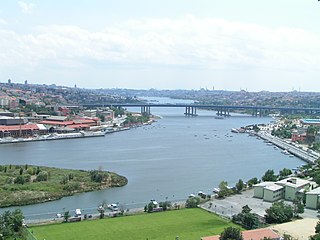
De origine actibusque Getarum, or the Getica, written in Late Latin by Jordanes in or shortly after 551 AD, claims to be a summary of a voluminous account by Cassiodorus of the origin and history of the Gothic people, which is now lost. However, the extent to which Jordanes actually used the work of Cassiodorus is unknown. It is significant as the only remaining contemporaneous resource that gives the full story of the origin and history of the Goths. Another aspect of this work is its information about the early history and the customs of Slavs.
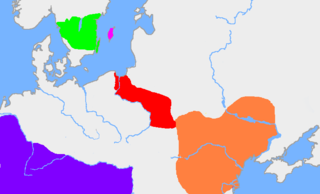
The Chernyakhov culture, or Sântana de Mureș culture, is an archaeological culture that flourished between the 2nd and 5th centuries AD in a wide area of Eastern Europe, specifically in what is now Ukraine, Romania, Moldova and parts of Belarus. The culture is probably the result of a multiethnic cultural mix of the Sarmatian, Slavic, Gothic, and Geto-Dacian populations of the area.

Oium or Aujum was a name for an area in Scythia, where the Goths, under King Filimer, arguably settled after leaving Gothiscandza, according to the Getica by Jordanes, written around 551. Jordanes does not give an etymology, but many scholars interpret this word as a dative plural to the widespread Germanic words *aujō- or *auwō- and means "well-watered meadow" or "island".
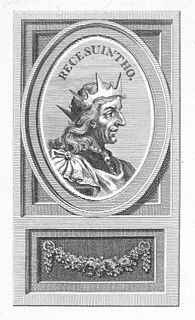
Recceswinth, also known as Reccesuinth, Recceswint, Reccaswinth, Recesvinto, Recceswinthus, Reccesvinthus, and Recesvindus (Latin), was the Visigothic King of Hispania, Septimania and Galicia in 649–672. He ruled jointly with his father Chindaswinth until his father's death in 653.
The Balt dynasty or Balth dynasty was the first ruling family of the Visigoths from 395 until 531. They led the Visigoths into the Western Roman Empire in its declining years.

Between about 376 and 382 the Gothic War against the Eastern Roman Empire, and in particular the Battle of Adrianople, is commonly seen as a major turning point in the history of the Roman Empire, the first of a series of events over the next century that would see the collapse of the Western Roman Empire, although its ultimate importance to the Empire's eventual fall is still debated.

The Thervingi, Tervingi, or Teruingi were a Gothic people of the Danubian plains west of the Dniester River in the 3rd and the 4th centuries. They had close contacts with the Greuthungi, another Gothic people from east of the Dniester, as well as the late Roman Empire or the early Byzantine Empire.
The Goths, Gepids, Vandals, and Burgundians were East Germanic groups who appear in Roman records in Late Antiquity. At times these groups warred against or allied with the Roman Empire, the Huns, and various Germanic tribes.

The Antes or Antae were an early Slavic tribal polity which existed in the 6th century lower Danube, on the regions around the Don river and northwestern Black Sea region. They are commonly associated with the archaeological Penkovka culture.

The Battle of Romania in World War II comprised several operations in or around Romania in 1944, as part of the Eastern Front, in which the Soviet Army defeated Axis forces in the area, Romania changed sides, and Soviet and Romanian forces drove the Germans back into Hungary.
Boz was the king of the Antes, an early Slavic people that lived in parts of present-day Ukraine. His story is mentioned by Jordanes in the Getica (550–551); in the preceding years, the Ostrogoths under Ermanaric had conquered a large number of tribes in Central Europe, including the Antes. Some years after the Ostrogothic defeat by the invading Huns, a king named Vinitharius, Ermanaric's great-nephew, marched against the Antes of Boz and defeated them. Vinitharius condemned Boz, his sons, and seventy of his nobles, to crucifixion, in order to terrorize the Antes. These conflicts constitute the only pre-6th century contacts between Germanics and Slavs documented in written sources.
Florin Constantiniu was a Romanian historian.


